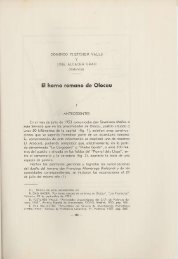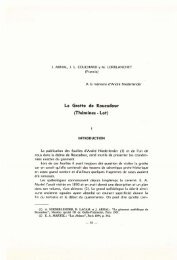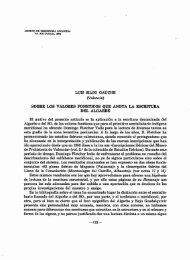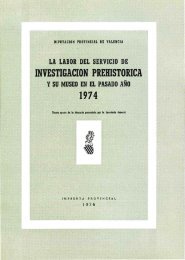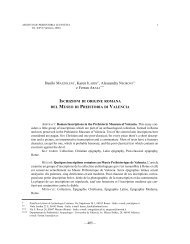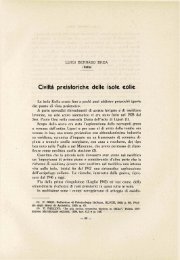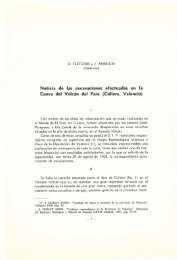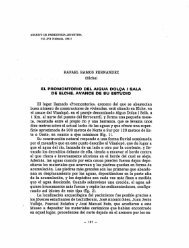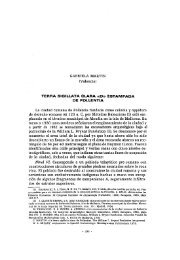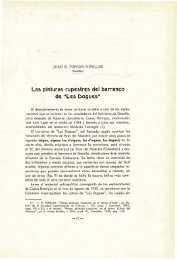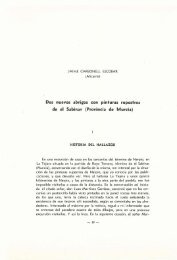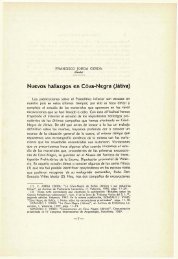Ancient Iberian Coinage - Museo Prehistoria
Ancient Iberian Coinage - Museo Prehistoria
Ancient Iberian Coinage - Museo Prehistoria
You also want an ePaper? Increase the reach of your titles
YUMPU automatically turns print PDFs into web optimized ePapers that Google loves.
<strong>Ancient</strong> <strong>Iberian</strong> <strong>Coinage</strong><br />
Pere Pau Ripollès<br />
DoDiA Documentos Digitales de Arqueología 02 | 2013<br />
Museu de Prehistòria de València
The <strong>Iberian</strong> Peninsula on the periphery of the Greek World<br />
The <strong>Iberian</strong> Peninsula is located in the western part of the Mediterranean, far from the cultural centers<br />
that fostered the main social and political developments throughout the first millenium BC. Nevertheless,<br />
it did not remain on the sidelines of the Mediterranean influences; from the beginning the presence of<br />
navigators and Punic traders have been detected, first Phoenicians, mainly in the zone South, and later<br />
Greeks, in the north.<br />
IberIan PenInsula<br />
Gadir<br />
Lixus<br />
Arse<br />
Agathe Massalia<br />
Ebusus<br />
Rhode<br />
Emporion<br />
Alalia<br />
Carthago<br />
Roma<br />
Tarento<br />
Neapolis<br />
Siracusa<br />
Corinto<br />
Abdera<br />
Atenas<br />
Egina<br />
Cnossos<br />
Cízico<br />
Focea<br />
Éfeso<br />
Olbia<br />
Heraclea<br />
Naucratis<br />
Panticapea<br />
Sinope<br />
Salamina<br />
Tiro<br />
2
The colonies, the emporia and centers exploiting resources constituted important<br />
points of contact with the native populations, through which an exchange of goods,<br />
services and ideas took place. From the first systematic contacts, silver was an<br />
important commodity for these traders and navigators and it very soon impregnated<br />
the life of the most developed populations of the Mediterranean coast of the <strong>Iberian</strong><br />
Peninsula.<br />
The land and its people<br />
The <strong>Iberian</strong> Peninsula was a territory inhabited by a remarkable variety of cultures<br />
with very different levels of social, political and economic development, depending on<br />
whether they were located on the coast, where contacts with traders and navigators<br />
extended advances and innovations, or inland, where access was more difficult.<br />
Between the native groups that lived in the <strong>Iberian</strong> Peninsula we find, on the South<br />
and the Mediterranean coast, a Late Bronze native people who evolved towards<br />
the <strong>Iberian</strong> culture, influenced by contacts with Greeks and Phoenicians. Some of<br />
their populations reached a notable urban development and they were structured in<br />
stratified social hierarchies. They spoke a non Indo-European language.<br />
Inside the <strong>Iberian</strong> Peninsula, to the south of the Ebro river and in the Eastern part of<br />
both Mesetas, were the Celtiberians; some of their populations developed forms of<br />
urban organization. The Greek influences arrived indirectly, through their contacts<br />
with the <strong>Iberian</strong>s. Their language belonged to the Indo-European family.<br />
Priest. Cádiz.<br />
7th century BC<br />
3
Peoples of the <strong>Iberian</strong><br />
Peninsula.<br />
6th to 1st century BC<br />
4
In the central and western part of Iberia, peoples lived with little Mediterranean influences and strong ties to<br />
their Late Bronze age traditions. They only developed into urban models from the Late-Republican period.<br />
The Phoenicians and Punics on the South coast, and Greeks on the northeast basically formed the settled<br />
foreign population in the <strong>Iberian</strong> Peninsula, exerting a great impact on the natives until the arrival of the<br />
Romans, at the end of the 3rd century BC. The colonies which they established, the emporiums that they<br />
frequented and the operating centres of natural resources (mines, fisheries), became important points of<br />
contact with the native populations.<br />
Sileno<br />
Capilla (Badajoz)<br />
7th century BC<br />
Of the diverse products that the first navigators came in search for in Iberia,<br />
silver was one of the most in demand. The use of Spanish silver has been<br />
attested in a ‘hacksilber’ hoard found in the East, for which the commercial<br />
intermediation of the Phoenicians has been advocated, and also in Auriol<br />
coinages, in France. Silver was soon integrated in the commercial life of the<br />
most important populations of the Mediterranean coast, becoming another<br />
form of money.<br />
Emporion<br />
Ca. 490-480 BC<br />
Auriol hoard<br />
Trihemiobol<br />
1.25 g - 8 mm<br />
5
Coins were minted in the <strong>Iberian</strong> Peninsula from the late 6th century BC until the reign of the emperor<br />
Claudius I, although their use spread gradually over time and space. The first push towards the monetization<br />
of the <strong>Iberian</strong> Peninsula took place by external motivations, as a result of the huge volume of issues minted<br />
during the Second Punic War.<br />
The first coinages were Greek<br />
The first coinages of the <strong>Iberian</strong> Peninsula were minted in the Phocaean colony of Emporion, towards<br />
the late 6th century BC, following a Phocaean standard. At the beginning, Emporion struck heavier<br />
denominations than Massalia, with pentobols, tetrobols, but from the early 5th century Emporitan coinages<br />
were characterized by their reduced weight, most of them weighing less than 1 g, and by the great diversity<br />
of types, following a model of minting similar to the one developed in Massalia; they are commonly<br />
denominated “fraccionarias ampuritanas” and lasted until late 4th century BC.<br />
Phocaean standard<br />
Drachm 5.52 g<br />
Pentobol 4.60 g<br />
Tetrobol 3.68 g<br />
Hemidrachm 2.76 g<br />
Trihemiobol 1.38 g<br />
Obol 0.92 g<br />
Tritartemorion 0.69 g<br />
Emporion<br />
515/510-500 BC<br />
Pentobol<br />
4.02 g - 12 mm<br />
6
The Emporitan pattern of minting fits well with that<br />
proposed for a good number of Greek coinages, according<br />
to which coins were not more than the result of the<br />
formalization of the use of the silver bullion, by means of<br />
codifying and stabilizing its use.<br />
The Emporitan coinages had a local purpose and use,<br />
discarding army financing or important trading activities.<br />
From its fractional character and its dispersion it can be<br />
deduced that these coinages had a wide base of users,<br />
Greeks and natives; due to the reduced value, a large<br />
segment of population had acces to them.<br />
Emporion<br />
515/510-500 BC<br />
Hemidrachm<br />
2.6 g - 11 mm<br />
Emporion. 500-480 a.C.<br />
Tritartemorion<br />
0.55 g - 7 mm<br />
Emporion. 460-400 a.C.<br />
Obol<br />
0.74 g - 8 mm<br />
7
Towards the end of the 4th century BC, the Greek colony of<br />
Rhode, located about 18 km to the north of Emporion, initiated the<br />
minting of drachms, with an average weight of 4.74 g, modifying the<br />
fractional monetary model used until then. This pattern must have<br />
originated in the Phoacean standard weight of Emporion. Rhode<br />
was, in addition, one of the first cities of the <strong>Iberian</strong> Peninsula to<br />
mint bronze coins, with a pattern of 4.12 g, and many of them were<br />
overstruck on bronze coinages of Punic Sardinia, issued during the<br />
first half of the 3rd century BC.<br />
Shortly after Rhode initiated the minting of drachms, the colony of Emporion<br />
also struck them with an average weight of ca. 4.70 g and ceased the issue of<br />
“fraccionarias” pieces. This new phase of Emporion took place at the beginning<br />
of the 3rd century BC and lasted intermittently until the second half of the 2nd<br />
century BC.<br />
←<br />
←<br />
Rhode. Late 4th century BC<br />
Drachm<br />
4.75 g - 19 mm<br />
Emporion. Early 3rd century BC<br />
Drachm<br />
4.75 g - 19 mm<br />
8
The types that were chosen for the first Emporion drachms (early 3rd century BC) were the female head<br />
with corn ears in hair, already used in drachms of Rhode. The reverses show a Nike flying over a horse,<br />
which has given room to think that the Carthaginians could have been to some extent involved in their<br />
manufacturing, perhaps for the payment of mercenaries recruited in Gaul, where these coinages were largely<br />
imitated.<br />
←<br />
→<br />
Gaul. Imitation of Emporion<br />
3rd century BC<br />
Drachm<br />
4.75 g - 18 mm<br />
Emporion<br />
Mid 3rd century BC<br />
Drachm<br />
4.74 g - 18 mm<br />
In the later issues types show a greater Syracusan influence, with a female head, adorned with an ear of<br />
wheat in her hair and surrounded by three dolphins, on the obverse, and the Pegasus with the legend<br />
ΕΜΠΟΡΙΤΩΝ, on the reverse. This typological change has been related to the backward movement<br />
of the Carthaginian influence, some years before, ca. 280-260 BC, or by Villaronga to the defeat of the<br />
Carthaginians in the First Punic War, ca. 241 BC.<br />
9
The use of silver as money<br />
As research progresses, it has become more evident that silver bullion by weight was used in small value<br />
transactions in some parts of the <strong>Iberian</strong> Peninsula.<br />
Every day, the findings of silver fragments or ingots, as well as Emporitan fractions, in premonetary<br />
indigenous contexts, are more frequently recorded, mainly coming from the coastal area. The evidence that<br />
allows us to believe in the existence of the use of the silver by weight are findings of<br />
silver ingots and fragments, such as those from La Bastida de les Alcusses (Moixent), an<br />
<strong>Iberian</strong> site that was abandoned in the 4th century BC, and those from Puig Castellar, in<br />
Pontós, with a chronology ranging from 5th to 3rd century BC.<br />
Silver bullion, scale pan and weights. 4th century BC<br />
La Bastida de les Alcusses<br />
Silver fragments from Sagunt<br />
10
Emporion.<br />
4th century BC<br />
Obol<br />
0.56 g - 9 mm<br />
Utrera<br />
Morella<br />
Montgó<br />
Pont de Molins<br />
Penedés<br />
Tarragona<br />
Puig de la Nau<br />
Empordà<br />
Rosas<br />
Emporion<br />
4th century BC hoards<br />
11
The content of some hoards also provides chronologies of 4th century BC, such as the Montgó and the Pont<br />
de Molins, which in addition to fractional coinages contained silver fragments of broken jewelry, silver ingots<br />
and Hacksilber. As far as the instruments of weighing is concerned, the pondera and the scale-pan are well<br />
known, some of which also go back to the 4th century BC.<br />
Supporting of an old context for the use of silver fragments we have an increasing number of diverse Greek<br />
coinages, struck during the 6th and 5th centuries BC, some of which were cut deliberately as it happens<br />
with silver fragments. It could be argued, however, that all these evidences have little to do with the use of<br />
the silver as money and much as commodity; nevertheless, the<br />
most interesting features of these findings are its small shape<br />
and the reduced weight of the fragments, giving rise to think<br />
that its use fits better within the money concept.<br />
Coins<br />
PUIG DE LA NAU - 130 g<br />
Objects and<br />
bullion<br />
PONT DE MOLINS - 2020 g<br />
MONTGÓ - 1172 g<br />
4th century BC hoards with total weight<br />
Greek coins from<br />
Segesta, Syracuse and Akragas<br />
12
The <strong>Iberian</strong>s adopted coinage<br />
The introduction of the coinage between the <strong>Iberian</strong>s was a delayed, slow<br />
and territorially unequal process. The <strong>Iberian</strong> world knew coinage in early<br />
parts of the 5th-4th centuries BC, because coins arrived in the hands<br />
of the natives through trade activities and the <strong>Iberian</strong> mercenaries who<br />
fought in the wars in the central Mediterranean between Greeks and<br />
Carthaginians, at least from 480 BC (Herodotus 7.165; Diod. 13.80.2).<br />
The first <strong>Iberian</strong> issues were struck in the city of Arse-Saguntum,<br />
presumably in the second half of the 4th century BC, in accordance<br />
with the development of their political organization. They must be<br />
linked with a process of regulation of their civic relations, during which<br />
important urban transformations and outstanding activities in their port<br />
took place. With its coinages, Arse-Saguntum did no more than begin to<br />
formalize the use of silver bullion valued by weight. But this was a unique<br />
advancement in Spain, because the beginning of native issues and an<br />
effective monetization only began in late 3rd century BC.<br />
Arse-Saguntum<br />
4th century BC<br />
Obol<br />
0.5 g - 8 mm<br />
Citadel of Saguntum<br />
13
Alexander III<br />
336-323 BC<br />
Distater<br />
17.17 g - 23 mm<br />
Arse-Saguntum<br />
300-250 BC<br />
Drachm<br />
3.11 g - 15 mm<br />
The designs and the artistic style of the coins struck in Arse are framed within a Greek-Hellenistic cultural<br />
atmosphere and show typological ties with the cities of Massalia, Magna Greece and Sicily, areas with which<br />
Arse-Saguntum maintained trade contacts.<br />
Neapolis<br />
350-325 BC<br />
Didrachm<br />
Arse-Saguntum<br />
3rd century BC<br />
Hemidrachm<br />
14
The monetization of the Phoenicians and the Punics<br />
The monetary model of the Phoenician-Punic people who settled in Spain varied<br />
with respect to the Greek colonies. Instead of using silver fractions for their<br />
routinely low level exchanges, they expressed an initial preference for bronze, as in<br />
Ebusus, from the second half of the 4th century BC, and Gadir, in the first years of<br />
the 3rd century BC. Silver was a product that these peoples searched for from an<br />
early time and it comprised one of the goods that were exchanged; nevertheless,<br />
when the Phoenician-Punic society began to articulate their monetary system they<br />
did it with bronze coins instead of silver ones. It seems obvious that these coinages,<br />
by their characteristics, were minted to cover local expenses. It is surprising that the<br />
Ebusus<br />
4th century BC<br />
Eighth<br />
1. 2 g - 11 mm<br />
Gadir<br />
3rd century BC<br />
Half<br />
15
Phoenician-Punic communities of Ebusus and the south of the <strong>Iberian</strong> Peninsula had not developed, previously<br />
or simultaneously, silver issues. That was, perhaps, due to the political and economic maturity of this society and<br />
to the fact that these issues were intended for modest transactions in a local context, which would exclude<br />
military financing for which the bronze coinages were not thought appropriate.<br />
The Carthaginians and the Second Punic War<br />
The natural evolution of the native societies towards the monetization accelerated with the presence of<br />
the Carthaginians and the development of the Second Punic War. The coin hoards of this period provide<br />
information on the type of coinages used to finance the war and the area of their circulation, mainly coastal.<br />
16
The Carthaginians covered their military<br />
expenses, largely, with metals mined in<br />
Iberia. The silver currency, whose<br />
unit was the shekel, was coined<br />
following an initial weight<br />
pattern of 7.20 g. Also,<br />
electrum coins were struck,<br />
and the monetary system<br />
was completed with bronze<br />
issues for daily use.<br />
The Carthaginian designs fit<br />
well within the Hellenistic<br />
pattern of coinages and its<br />
cultural atmosphere; they<br />
were varied, with prows,<br />
masculine and feminine<br />
portraits, elephants and horses.<br />
The war financing purpose of<br />
these issues is why the mint struck<br />
such high denominations and the<br />
output was so huge.<br />
Hispano-<br />
Carthaginian<br />
237-218 BC<br />
Trishekel<br />
17
←<br />
Hispano-Carthaginian<br />
218-202 BC<br />
1/4 stater<br />
2.78 g - 16 mm<br />
←<br />
Hispano-Carthaginian<br />
218-202 BC<br />
Unit<br />
10.14 g - 25 mm<br />
←<br />
Hispano-<br />
Carthaginian<br />
218-202 BC<br />
Trishekel<br />
22.5 g - 29 mm<br />
18
On the other hand, the Romans<br />
financed their military expenses with a<br />
more varied source of currencies, but,<br />
unlike the Carthaginians, they mainly<br />
used local mints and designs. Most of<br />
the payments were made with drachms<br />
from Emporion with the Pegasus type,<br />
with the head transformed on the<br />
reverse, which explains the huge volume of coins<br />
minted by the city in a short period of time.<br />
Other coinages found in the coin hoards<br />
buried during the years of the war are the<br />
<strong>Iberian</strong> imitations of Emporion drachms and of<br />
Massaliotan obols, some with recognizable name<br />
place legends. The <strong>Iberian</strong> imitation drachms<br />
were minted in a military context and it is<br />
possible that they were struck with the<br />
intention of meeting some war expenses of<br />
the Roman side.<br />
←<br />
Emporion<br />
218-206 BC<br />
Drachm<br />
4.63 g - 19 mm<br />
←<br />
<strong>Iberian</strong> imitation<br />
3rd-2nd century BC<br />
Drachm<br />
4.58 g - 19 mm<br />
19
Other silver coinages that could be related to the war, although they appeared with a much more modest<br />
volume, were the Gallic issues “à la croix” (and others not very well attributed), those of Massalia, Greek<br />
Hellenistics of diverse origin, those of Ebusus, Gadir, Arse and Saitabi; also several bronze issues are<br />
attributed to this period, like those minted in Castulo, Obulco or Gadir.<br />
Ebusus<br />
Late 3rd century BC<br />
Drachm<br />
2.54 g - 17 mm<br />
Saitabi<br />
Post 214 BC<br />
Didrachm<br />
6.80 g - 21 mm<br />
Gadir<br />
Late 3rd century BC<br />
Hemidrachm<br />
2.3 g - 17 mm<br />
20
Hoards buried 218-195 BC<br />
Precise location<br />
Approximate location<br />
Number of dies used during the period 218-195 BC<br />
The financing of the war contributed in a decisive way to the familiarisation and coin use by the indigenous<br />
population. Nevertheless, coins did not extend through the whole territory uniformly, since the findings of<br />
hoards indicate that they were concentrated basically on the Mediterranean coastal strip, rarely entering inland,<br />
as well as on the Guadalquivir valley. Carthaginian coinages were predominant in the south, while those of the<br />
Roman side in the northeast.<br />
21
Territories under Roman<br />
control and their provincial<br />
partition, ca. 197 BC<br />
Iaka<br />
Rhode<br />
Bolskan Iltirta Ausa<br />
Emporion<br />
Saltuie<br />
Barkeno<br />
Kelse<br />
Kese<br />
The Roman<br />
dominion<br />
CITERIOR<br />
After the defeat of the Carthaginians<br />
the Roman Senate decided to remain<br />
Arse<br />
in the <strong>Iberian</strong> Peninsula in order to<br />
exploit its resources. The dominated part<br />
Saitabi<br />
was divided in two provinces, the Hispania<br />
Baecula<br />
Lucentis<br />
Citerior and the Hispania Ulterior, each one<br />
Ilipa<br />
Castulo Ilici<br />
Obulco<br />
under the command of a praetor, with authority<br />
Carmo<br />
Carthago Nova<br />
to intervene in the local policies, probably including<br />
Urso<br />
VLTERIOR Baria<br />
the manufacture of coinages. The first province, over<br />
Malaca<br />
Gades<br />
Seks Abdera<br />
time, included within its boundaries Gallaecians, Asturians,<br />
Cantabrians, Celtiberians, Vascons, towns of the Pyrenees and<br />
<strong>Iberian</strong>s, and the second province the <strong>Iberian</strong>s of the South-east,<br />
Turdetanians, Lusitanians, Vetons, Punics and peoples of the south of Portugal.<br />
The Roman presence had important repercussions in the life of the <strong>Iberian</strong> Peninsula natives, generating a<br />
slow and complex process of assimilation and sociocultural exchanges and, simultaneously, a series of legal<br />
changes on the subjected populations. The Roman dominion favored the contacts between the different<br />
peninsular people; integrated their productive economies in those of the Roman state, and, during the 2nd<br />
and 1st centuries BC, contributed to the increase of coin use, making it more habitual.<br />
22
At this time, the Roman society was in a process of important monetization, the Romans encouraged the<br />
urban organization and, with it, the tendency towards a monetized economy. The presence of the army<br />
and the arrival of colonists, craftsmen and businessmen, were very important because all of them were<br />
accustomed to and dependent on the use of coinages. However, as a result of the repeated remittances of<br />
booties to Rome in the first decades of the 2nd century BC (Livy, 34, 10, 4-7; 34, 46, 2; 40, 43, 6) and of the<br />
shortage of the native issues, the monetization of the economy took more than fifty years to develop. A<br />
case in point is the rarity of the Second Punic War coinages in findings dated during the first half of the 2nd<br />
century BC, both isolated and hoards.<br />
Roman coinages did not contribute either, at the outset, to the development of the monetization among the<br />
natives, since until the second half of the 2nd century BC few Roman coins arrived to Spain.<br />
Peter Paul Rubens<br />
A Roman Triumph<br />
[National Gallery, London]<br />
23
Metals and denominations<br />
During the 2nd and 1st centuries BC,<br />
coins in Spain were made of silver and<br />
bronze, except the imperial gold issues<br />
attributed to Patricia (RIC 50-153) and<br />
Caesaraugusta (RIC 26-49). The ternary<br />
bronze (copper, tin and lead) was<br />
mostly used in both provinces, as in the<br />
Mediterranean at this time; pure copper<br />
has also been recorded in Celtiberian<br />
mints and an alloy of copper and lead was<br />
found in some issues of Castulo, Obulco,<br />
Ikalesken and Kelin.<br />
The identification of the native bronze denominations is<br />
HISPANIA<br />
VLTERIOR<br />
HISPANIA<br />
CITERIOR<br />
complex, because the Roman names of denominations were not suitable, due to the variations of weight<br />
with respect to the Roman standard, presumably because native bronze coinages had a local intention. At the<br />
outset, many issues were minted following a high weight average, around 20-24 g, but later, those coinages<br />
articulated around 9-13 g tended to be more common. However, it seems that the bronze coinage tended to<br />
follow the Roman standard using weights easily convertible to Roman denominations.<br />
Copper alloys<br />
Copper<br />
Copper & lead<br />
Copper, lead & tin<br />
24
Saitabi<br />
2nd century BC<br />
Reduced uncial as<br />
23.92 g - 32 mm<br />
Laiesken<br />
2nd century BC<br />
Unit<br />
19.28 g - 31 mm<br />
25
Concerning the silver coinages of the 2nd-1st centuries BC, the average quality of the metal minted was<br />
relatively high, although some mints located in the Meseta display more dispersed values and with an average<br />
of slightly inferior quality, below 90%. All silver coins were minted in the Citerior and the majority adopted the<br />
weight of the Roman denarius, for that reason they probably had an equivalent value.<br />
100%<br />
90%<br />
80%<br />
←<br />
←<br />
ca. 130 BC<br />
Turiazu<br />
Ca. 120 BC<br />
Denarius<br />
4.28 g - 19 mm<br />
Iltirta<br />
Ca. 175-150 BC<br />
Denarius<br />
3.75 g - 19 mm<br />
Fineness of the <strong>Iberian</strong> denarii struck at Turiazu.<br />
ca. 72 BC<br />
26
No city in the Hispania<br />
Ulterior minted silver<br />
coinages, however the<br />
territory was supplied with<br />
silver coinages, native or<br />
Roman. This location is<br />
one of the most notable<br />
differences between<br />
both provinces. Such<br />
distribution of the silver<br />
coinages has leads us to<br />
assume that some type of<br />
directive or norm from<br />
the Roman administration<br />
existed, allowing the<br />
Citerior to strike silver<br />
but not allowing the<br />
Ulterior. To do so, at the<br />
moment, no explanation<br />
that justifies the absence of<br />
silver issues in the Ulterior<br />
is satisfactory.<br />
Mints issuing silver coinages during<br />
the 2nd and 1st centuries BC<br />
Certain location<br />
Approximate location<br />
27
Monetization as effect of civic impetus<br />
The native coinages were promoted by the city authorities, which could at that time define their characteristics,<br />
perceivable not only in the designs, but also in the scripts used on the legends. The monetization of the <strong>Iberian</strong><br />
Peninsula took place largely from within, from the issues minted by more than 160 populations. This was linked<br />
with their development, and the existence of economies in which payment and retail trade were usual and<br />
until a certain point necessary, as was the case of the mining zones (Castulo), the rich agricultural territories<br />
(Obulco), the harbour areas (e.g. Untikesken, Arse-Saguntum, Malaca, Gadir) or the military establishments.<br />
Castulo<br />
Ca. 130-100 BC<br />
As<br />
18.45 g<br />
Obulco<br />
Ca. 130-100 BC<br />
As<br />
11.82 g<br />
Untikesken<br />
2nd century BC<br />
Unit<br />
28
+ 40 mints<br />
of uncertain<br />
location<br />
Mints issuing coinages during<br />
the 2nd and 1st centuries BC<br />
29
Regarding the silver issues, although some could be struck for local purposes (e.g. Arse, Iltirta, Ausesken,<br />
Kese), a good part was minted in Celtiberian cities and the Pyrenean area (Bolskan, Arsaos, Sekobirikez,<br />
Arekorata or Turiazu). They were more likely originated in a military context (to pay auxiliary troops), than<br />
struck to cover Roman regular fiscal taxes.<br />
Kese<br />
Ca. 180-150 BC<br />
Denarius<br />
3.86 g - 19 mm<br />
Arsaos<br />
Late 2nd century BC<br />
Denarius<br />
3.78 g - 19 mm<br />
Bolskan<br />
Late 2nd century BC<br />
Denarius<br />
3.83 g - 19 mm<br />
30
Turiazu<br />
Ca. 100 BC<br />
Denarius<br />
3.83 g - 19 mm<br />
400<br />
200<br />
AR AE<br />
Number of obverse dies used for<br />
silver and bronze issues of Turiazu<br />
Turiazu<br />
2nd-1st century BC<br />
Unit<br />
3.78 g - 19 mm<br />
Most of the mints that coined huge amounts of silver were inland and struck a reduced amount of bronze<br />
(units and fractions), which suggests that they were not minted for local purposes, as was the case of<br />
Turiazu, where for denarii about 400 obverse dies were used, whereas for all bronze denominations only<br />
30 have been identified.<br />
The civic coinages were used all around the <strong>Iberian</strong> Peninsula without any type of restriction; the findings<br />
in the cities correspond to issues coming from the neighbouring cities or from places that struck a huge<br />
volume, providing the greatest amount of bronze coinage that <strong>Iberian</strong>s used. To a lesser extent, we also<br />
found the <strong>Iberian</strong> Issues in North Africa and in Gaul.<br />
31
Designs<br />
During the 2nd-1st centuries BC,<br />
the native populations had quite an<br />
autonomous development, in which<br />
they adapted the coinage concept<br />
to their idiosyncrasies. The native<br />
issues took on Greek-Hellenistic<br />
iconographical figures from diverse<br />
origins that by their repeated use<br />
became characteristic icons of<br />
a series of mints or regions (e.g.<br />
corn ears, Hercules, sphinx, bull,<br />
horseman). The few connections of<br />
the designs and the ideology of the<br />
Hispanic coinages with the Roman<br />
cultural world could be explained<br />
by the autonomy that the Hispanic<br />
communities enjoyed, since Rome<br />
did not yet have a standardized<br />
iconography of cultural symbols.<br />
Castulo<br />
2nd century BC<br />
Unit<br />
Seks<br />
2nd century BC<br />
Unit<br />
Arse-Saguntum<br />
2nd century BC<br />
Drachm<br />
32
Some characteristics of the designs allow us to establish differences in the monetary production of the<br />
two Hispanic provinces. In cities from the Citerior province, the monetary types were characterized<br />
by being rather uniform. For the bronze units and the silver denarii, the male head on the obverse, and<br />
the horseman with spear, palm or another object on the reverse, was preferred. The obverse could<br />
represent the founding hero or a local divinity of the ethnic group and the reverse could be chosen to<br />
fulfil values or beliefs of the elites of equestrian tradition, as has been suggested by Almagro.<br />
Arse-Saguntum<br />
2nd century BC<br />
Unit<br />
14.17 g - 26 mm<br />
Kili<br />
2nd century BC<br />
Unit<br />
14.17 g - 26 mm<br />
33
On the bronze fractions the<br />
designs were a little more<br />
varied and in many occasions<br />
they identified the value of the<br />
denominations, as was the case<br />
of the horses for halves and<br />
the half Pegasus for quarters.<br />
The homogeneity of types and<br />
scripts suggests the will to be<br />
a participant in a monetary<br />
circuit with recognizable and<br />
homologous pieces.<br />
In the Ulterior province, however,<br />
there was a greater variety of<br />
monetary designs, among which<br />
the horseman was occasional,<br />
and many were chosen from the<br />
flora; in addition, the existence of<br />
a standardized system of fractions<br />
distinguished by designs is less<br />
evident.<br />
Kelse<br />
2nd century BC<br />
Half<br />
6.52 g - 22 mm<br />
Kelse<br />
2nd century BC<br />
Quarter<br />
3.6 g - 17 mm<br />
Kese<br />
2nd century BC<br />
Sixth<br />
2.41 g - 14 mm<br />
34
Their designs reflected manifold facets of their identity. They alluded to their cults, like Hercules in Gadir,<br />
Seks, Asido and Lascuta; Jupiter-Saturn in Carteia; Hefaistos-Vulcano and Helios-Sun in Malaca; and male and<br />
female local divinities like in Castulo, Obulco or Carmo. The religious designs were numerous as well as<br />
those related to the economic resources of the cities (tunas in Gadir and Seks, corn ears in Obulco, Ilipa, Ilse,<br />
Murtili, Laelia, Acinipo or Carmo).<br />
Malaca<br />
2nd century BC<br />
Unit<br />
8 g - 25 mm<br />
Obulco<br />
2nd century BC<br />
Unit<br />
19.72 g - 32 mm<br />
Ilse<br />
2nd century BC<br />
Unit<br />
35
Legends<br />
Another relevant characteristic of the ancient coinages of the <strong>Iberian</strong> Peninsula was the script they used.<br />
The development of the cultural features of the native societies that took place during the 2nd-1st centuries<br />
BC, as a form of autonomy and self-representation of the elites, can also be detected in the epigraphy, which<br />
reflects the diversity of existing peoples in Hispania, the Roman consent, as well as the encouragement of the<br />
urban life.<br />
Pre-Latin languages in the <strong>Iberian</strong> peninsula Scripts used in the <strong>Iberian</strong> peninsula<br />
Lusitanian<br />
Tartesian<br />
Phoenician-Punic<br />
Aquitanian<br />
Celtiberian<br />
<strong>Iberian</strong><br />
Greek<br />
South-Lusitanian<br />
Latin<br />
Punic<br />
<strong>Iberian</strong><br />
Meridional<br />
<strong>Iberian</strong><br />
Greek<br />
36
Coin legends give evidence of diverse types of script. Foreign cultural groups used their own, like Greek and<br />
Punic. However, the native population used at least three types of scripts. The ‘Levantine <strong>Iberian</strong>’ was used in<br />
<strong>Iberian</strong> area and it was employed to write the Celtiberian language. The ‘Meridional <strong>Iberian</strong>’ script was used in<br />
the Southeastern half of the Peninsula (e.g. Ikelesken). Finally, the denominated ‘Tartessian’ or ‘South-Lusitanian’<br />
script, of which virtually everything is unknown, and is only recorded on the issues of Salacia (Portugal).<br />
Ikalesken<br />
2nd century BC<br />
Denarius<br />
Salacia-Ketouibon<br />
2nd century BC<br />
Unit<br />
14.92 g - 28 mm<br />
37
In addition, many native populations of the Hispania Ulterior used Latin script from the beginning, but in<br />
a restricted way and for official aims (e.g. place names). This does not demonstrate that a majority of the<br />
population knew Latin, but rather that it was a specific package of Latin use, which could be defined as<br />
coinage literacy.<br />
Lastigi<br />
2nd century BC<br />
Half<br />
6.25 g - 25 mm<br />
Acinipo<br />
Ulia<br />
1st century BC<br />
2nd century BC<br />
As As<br />
23.66 g - 32 mm<br />
38
Colonies<br />
Municipalities<br />
Pompey Caesar<br />
Augustus Uncertain<br />
The impact of the<br />
legal promotions<br />
of the cities<br />
From the 1st century<br />
BC, the establishment<br />
of Roman colonies and<br />
the legal promotion of<br />
indigenous cities, converted<br />
into municipalities, constituted the<br />
beginning of a new stage in the monetary<br />
history of Hispania. Their number was important,<br />
because under Pompey, Caesar and Augustus twentythree<br />
colonies were created and up to seventy-seven<br />
cities granted the municipal status.<br />
These foundations meant important changes in the<br />
socio-political geography of the <strong>Iberian</strong> Peninsula and<br />
allowed the indigenous elites and the new established<br />
population to acquire the Roman citizenship.<br />
39
In the native promoted cities, the social and political changes affected urbanism, the government magistracies,<br />
the personal and place names, the monetary designs, etc. The founding of the colonies contributed to the<br />
diffusion of the Italo-Roman symbols of identity and explains the disappearance of the indigenous cultural<br />
features in the surrounding areas, due to the origin of their settlers.<br />
Amphitheatre of Segobriga (Saelices, Cuenca)<br />
40
New designs for a new society<br />
The new political situation, the legal changes granted to<br />
the cities, and the new contingents of settled populations<br />
motivated a change in the designs of the coinages of the<br />
cities. They started looking more Roman, similar to what<br />
happened to other external signs of the Hispanic society.<br />
The new coin types had, mostly, a Roman meaning because<br />
they were chosen by the elites of the promoted cities and<br />
because many were inspired by and copied from Roman<br />
issues. From Augustus on, the messages that the<br />
coinages transmitted were in accordance with the<br />
new imperial ideology of legitimizing the emperor<br />
and his successors, proclaiming their loyalty to<br />
the emperor and the new state.<br />
The Roman provincial issues showed on the<br />
obverse the portrait of the emperor and, in<br />
time and to a lesser extent, some members<br />
of his family, contributing to make the imperial<br />
portrait one of the most characteristic symbols<br />
of contemporary coinage.<br />
Caesaraugusta<br />
Augustus<br />
As<br />
13.57 g - 28 mm<br />
41
The date of portrait introduction in the coinages of Hispania is uncertain and few of them can be dated with<br />
certainty before the twenties BC. The generalization of the imperial portrait, usually wreathed, has raised the<br />
question of their obligatory nature, but several exceptions, like Carteia (colonia) and Emporiae (municipium),<br />
seem to indicate that the cities adopted it voluntarily.<br />
The election of the imperial portrait for the obverses implied that the cities only had the reverses to show<br />
designs with local meaning. For this side of the coin, several types were chosen, often adapted from the<br />
Roman monetary designs.<br />
Carteia<br />
Late 1st century BC<br />
Quarter<br />
4.99 g - 18 mm<br />
Emporiae<br />
Late 1st century BC<br />
As<br />
42
REPUBLICAN<br />
IMPERIAL<br />
Untikesken<br />
Emporiae<br />
The Roman provincial coinages designs often reflected the origin and the culture of the populations of both<br />
types of privileged cities of Hispania, the colonies (foreign people) and the municipalities (native settlers).<br />
At the outset, some municipalities maintained designs from their previous issues, those minted during the<br />
Republican time; although, most were replaced during the reign of Tiberius by others based on Roman<br />
coinages. The maintenance of the traditional designs suggests that these accounted for their identity and that<br />
with them called attention to their history, such as in Emporiae and Osca.<br />
Bolskan<br />
Osca<br />
43
In the colonies, the designs referred to<br />
another cultural horizon. In them, types<br />
with Roman symbolism and without<br />
connection to the previous indigenous<br />
iconography of their surroundings were<br />
used. They alluded to the origin of the<br />
settled population, in the case of veterans<br />
by means of legionary standards; to the<br />
Roman ritual of colonization;<br />
to the symbols of the<br />
Roman religion; to the<br />
imperial cult, with the<br />
election of altars and<br />
temples; and to dynastic<br />
themes, influenced by<br />
the Roman issues and<br />
the political context of<br />
the time.<br />
Tarraco<br />
Tiberius<br />
Dupondius<br />
Caesaraugusta<br />
Tiberius<br />
As<br />
Emerita<br />
Augustus<br />
As<br />
44
However, the iconographic difference between municipalities and colonies was not absolute, since in both<br />
types of cities similar designs were also used, such as wreaths or bulls. The latter was depicted standing<br />
or walking (in Lepida also running) with or without pediment on the horns. This ornament, known in the<br />
Republican monetary iconography (RRC 455/4) and in reliefs (Ara Pietatis, Boscoreale cup, altar of Domitius<br />
Ahenobarbus), as a part of scenes of sacrifice, suggests the bull had a religious meaning (e.g. Tarraco,<br />
Caesaraugusta, Graccurris and Ercavica).<br />
←<br />
Colonia Patricia<br />
Augustus<br />
As<br />
←<br />
Colonies<br />
Caesaraugusta<br />
Tiberius<br />
As<br />
←<br />
Graccurris<br />
Tiberius<br />
As<br />
Municipalities<br />
←<br />
Segobriga<br />
Caligula<br />
As<br />
7.04 g - 22 mm<br />
45
Latin prevailed<br />
The promotion of native cities and the foundation of colonies accelerated the disappearance of the non<br />
Latin scripts from the public manifestations. In the last years of the Republican period, a part of the society<br />
had already been Latinized, as seen from the reduction of the pre-Roman epigraphic testimonies, the<br />
existence of bilingual legends and from the increase of Latin writings.<br />
AVGVSTO<br />
PONTIFICI MAX IMP<br />
XIIII COS XII TRIB<br />
POTEST XV MVNICIP<br />
SAGVNTINI<br />
Pedestal of Augustus<br />
found in Saguntum<br />
Theatre of Saguntum<br />
46
Abdera<br />
Tiberius<br />
As<br />
Ebusus<br />
Tiberius<br />
As<br />
The epitaphs and dedications used Latin, and very soon this practice became a Roman cultural act for<br />
natives, revealing the acceptance of the culture of the rulers and recognizing Latin as a prestige language.<br />
In the privileged cities the use of Latin is attested on all official manifestations, and the coin legends<br />
reinforced this dynamic; however, some exceptions can be found on provincial coinages from Ebusus and<br />
Abdera, which used bilingual legends in Latin and Punic to indicate their place name. A singular case is<br />
attested in Saguntum, to which a rare issue in Greek is attributed. However, in the domestic sphere natives<br />
kept using pre-Latin scripts for a while.<br />
Julio-Claudian<br />
bilingual inscription<br />
from Saguntum<br />
Saguntum<br />
Late Ist century BC<br />
As<br />
47
What the legends tell<br />
The legends of the Roman provincial coinages provided more information than the native issues struck<br />
during the Republican time, because they contained more words and more abbreviations, following the late<br />
Republican and Imperial models. The wide adoption of the portrait of the emperor in the obverses made<br />
an identifying legend necessary. With Augustus, the imperial title on the coin legends was varied, and only<br />
became regularized over time, becoming more systematized during the reigns of Tiberius and Caligula.<br />
PERM · CAES · AVG<br />
Colonia Patricia<br />
Augustus<br />
As<br />
TI · CAESAR · DIVI · AVG · F · AVGVSTVS ·<br />
Caesaraugusta<br />
Tiberius<br />
As<br />
G · CAESAR · AVG · GERMANICVS · IMP<br />
Caesaraugusta<br />
Caligula<br />
As<br />
48
Local information was displayed on the reverses. This was the most usual place for naming the minting cities,<br />
with or without an indication of their legal status; and the magistracies held by those who were in charge of<br />
the issue (mostly in the Tarraconensis province); of these, the IIviri were the most recorded; also quattuorviri,<br />
aediles, quaestores and praefecti were mentioned, although with much less frequency. The reverse legends also<br />
identified divinities and allegorical figures represented in the designs and allow us to know the meaning and<br />
intention of the objects and monuments engraved.<br />
Caesaraugusta<br />
Tiberius<br />
C · CA · T · CAECILIO · LEPIDO · G · AVFIDIO · GEMELLO · II · VIR ·<br />
←<br />
←<br />
As<br />
Caesaraugusta<br />
Caligula<br />
As<br />
C · C · A LICINIANO · ET · GERMANO II · VIR<br />
49
Why the cities minted<br />
The Roman provincial coinages of Hispania<br />
were only struck in bronze (from the reign of<br />
Tiberius a few mints used copper for the asses<br />
and orichalcum for the dupondii and sestertii:<br />
Caesaraugusta, Tarraco, Ilici or Osca) and<br />
almost always in a discontinuous rhythm. These<br />
features, together with the fact that the most<br />
minted denominations were the asses and<br />
semisses, suggest that cities put in circulation<br />
a relatively modest amount of wealth, destined<br />
for local use and function, and being very useful<br />
for the payment of small value exchanges.<br />
The civic issues increased and refreshed the<br />
stock of bronze coinages that was in circulation<br />
in Hispania, because at the beginning of the<br />
reign of Augustus it was scarce and well worn,<br />
partially due to the low coin production in<br />
the course of the five preceding decades, both<br />
Roman and native.<br />
SESTERTII<br />
178<br />
68<br />
DUPONDII<br />
SEMISES<br />
1191<br />
ASSES<br />
2287<br />
163<br />
QUADRANTES<br />
Estimation of dies for the Roman provincial coinages of Hispania<br />
50
Imperial and provincial coins circulation in Hispania<br />
The monetary findings of civic coinages suggest they<br />
fulfilled an important task in the monetization of Hispania,<br />
reaching in certain cities up to 85% of all bronze coinages in<br />
circulation.<br />
The provincial issues of Hispania are correlated with<br />
local motivations, but their production did not reach,<br />
in many cities, to meet the most basic expenses of<br />
their administration, as they could be the wages of the<br />
apparitores, the maintenance of the public slaves and the<br />
public games (Lex Ursonensis 62). The precise reasons<br />
that lead the cities to strike coins are difficult to identify,<br />
although they must searched within themselves and not<br />
in financial necessities of the Roman state. They had to<br />
be diverse and some could be concurrent, like financing<br />
services and public works, providing coinages for daily<br />
retail trade through moneychangers; beneficent actions of<br />
money distribution; profiting from the minting issues; some<br />
type of commemoration or celebration; prestige for having<br />
their coinage or the opportunity to engage an engraver or<br />
a workshop. Providing coinage to the army has also been<br />
the alleged function of some mints. It is probable that army<br />
51
settlements exerted a powerful attraction on the provincial coinages<br />
and could even prompt some issues by virtue of their benefit on<br />
the part of the city or of their citizens, because the bronze coinages<br />
optimized the use of silver coins and favoured the exchanges.<br />
The end of civic coinages<br />
From the reigns of Caligula/Claudius I on, the coinages of the Roman<br />
cities of Spain ceased. This end must be connected to the western<br />
imperial context, to which Hispania belonged, and must be viewed<br />
from a wider perspective that includes the western part of the<br />
Empire, which was immersed in a trend towards the unification of<br />
the Roman monetary system, in which civic bronze coinages were<br />
progressively replaced by Imperial ones.<br />
Diverse hypotheses have tried to explain the end of the minting in<br />
Spain, by means of political reasons, of economic weakness of the<br />
cities or preference for the Imperial coinages; nevertheless, none of<br />
them seems completely satisfactory by itself. With the end of the<br />
Roman provincial coinages during the reign of Claudius I, one of the<br />
most important public symbols of the cities disappeared and thereby<br />
concluding five hundred years of civic coinages. Henceforth, all the<br />
coinages used in Spain came from the Imperial mints.<br />
Ebusus<br />
Claudius I<br />
As<br />
52
FURTHER READING<br />
Alfaro, C., et al., Historia monetaria de Hispania Antigua, Madrid, 1998.<br />
Burnett, A., Amandry, M., Ripollès, P. P., Roman Provincial <strong>Coinage</strong> I, London-Paris, 1992.<br />
Chaves, F., “Las amonedaciones hispanas en La antigüedad” in J. Andreu Pintado, J. Cabrero Piquero and<br />
I. Rodà de Llanza (eds.), Hispaniae. Las provincias hispanas en el mundo romano, Tarragona, 2009.<br />
García-Bellido, M. P. y Blázquez, C., Diccionario de Cecas y Pueblos Hispánicos, Madrid, 2001.<br />
Hill, G. F., Notes on the <strong>Ancient</strong> <strong>Coinage</strong> of Hispania Citerior, New York, 1931.<br />
Ripollès, P. P. , Las acuñaciones romanas provinciales de Hispania. Madrid, 2010.<br />
Ripollès, P. P. “The <strong>Ancient</strong> <strong>Coinage</strong>s of the <strong>Iberian</strong> Península”, in W. Metcalf (ed.) Oxford Handbook of<br />
Greek and Roman <strong>Coinage</strong>s, Oxford, 2011, p. 356-374.<br />
Untermann, J., Monumenta Linguarum Hispanicarum, I. Die Münzlegenden, Wiesbaden, 1975.<br />
Villaronga, L., Numismática Antigua de Hispania. Iniciación a su estudio, Barcelona, 1979.<br />
Villaronga, L., Corpus Nummum Hispaniae ante Augusti Aetatem, Madrid, 1994.<br />
URL<br />
www.uv.es/ripolles/Web_PP/Docencia_biblio.html<br />
53
IMAGE CREDITS [left to right, top to bottom]<br />
All private collection images by Pere Pau Ripollès and Manuel Gozalbes<br />
01 Private collection<br />
03 © <strong>Museo</strong> Arqueológico Nacional<br />
04 © Esri (basemap)<br />
05 © <strong>Museo</strong> Arqueológico Nacional;<br />
© Bibliothèque nationale de France<br />
(author: P. P. Ripollès)<br />
06 Private collection<br />
07 Private collection<br />
08 © Bibliothèque nationale de France<br />
(author: P. P. Ripollès); The British<br />
Museum (author: P. P. Ripollès)<br />
09 Private collection<br />
10 Private collection; Museu de Prehistòria<br />
de València<br />
11 © Esri (basemap); private collection<br />
12 Museu de Prehistòria de València (left);<br />
Private collection (rest)<br />
13 Private cillection; Sagunt (author: M.<br />
Gozalbes)<br />
14 Solon Numismatics; private collection;<br />
The British Museum (author: P. P.<br />
Ripollès); private collection<br />
15 Private collection; Cores collection<br />
16 Lemco<br />
17 Private collection<br />
18 Private collection<br />
19 Private collection<br />
20 Private collection<br />
21 © Esri (basemap)<br />
22 © Esri (basemap)<br />
23 © National Gallery, London<br />
24 © Esri (basemap)<br />
25 Private collection; Cores collection<br />
26 Private collection<br />
27 © Esri (basemap)<br />
28 Museu de Prehistòria de València (2);<br />
private collection<br />
29 © Esri (basemap)<br />
30 Private collection (first two); Museu de<br />
Prehistòria de València<br />
31 Museu de Prehistòria de València;<br />
Montañes collection<br />
32 Private collection; Cores collection;<br />
private collection<br />
33 The British Museum (author: P. P.<br />
Ripollès): Museu de Prehistòria de<br />
València<br />
34 Private collection; Museu de Prehistòria<br />
de València; private collection<br />
35 Museu de Prehistòria de València (2);<br />
private collection<br />
36 © Esri (basemap)<br />
37 Private collection<br />
38 Museu de Prehistòria de València; private<br />
collection; Museu de Prehistòria de<br />
València<br />
39 © Esri (basemap)<br />
40 © Junta de Castilla-La Mancha<br />
41 ex HSA, New York (author: P. P. Ripollès)<br />
42 Museu de Prehistòria de València [ex<br />
HSA, New York] (author: P. P. Ripollès);<br />
private collection<br />
43 Private collection; Vico 14/11/2012,<br />
lot 116 (ex HSA, New York); private<br />
collection; private collection<br />
44 Private collection; ex HSA, New York<br />
(author: P. P. Ripollès); private collection<br />
45 Private collection (3); Museu de<br />
Prehistòria de València<br />
46 Museu Arqueològic de Sagunt (author: P.<br />
P. Ripollès)<br />
47 J. A. Herrero 24/5/2012, lot 17; private<br />
collection; Museu de Prehistòria de<br />
València; Museu Arqueològic de Sagunt<br />
(author: P. P. Ripollès)<br />
48 Private collection<br />
49 Private collection<br />
52 Private collection<br />
53 Saguntum coast (author: M. Gozalbes)<br />
54
DoDiA Documentos Digitales de Arqueología 02 | 2013<br />
Museu de Prehistòria de València<br />
<strong>Ancient</strong> <strong>Iberian</strong> <strong>Coinage</strong><br />
Pere Pau Ripollès<br />
2013<br />
v. 1.0<br />
DoDiA · Documentos Digitales de Arqueología es una publicación electrónica sin periodicidad<br />
fija y de distribución gratuita. Sus trabajos, realizados por especialistas, tienen un carácter<br />
esencialmente divulgativo y han sido concebidos para su lectura en dispositivos electrónicos.<br />
Museu de Prehistòria de València<br />
Corona 36 | 46003 Valencia | España<br />
www.museuprehistoriavalencia.es<br />
Maquetación: Manuel Gozalbes<br />
Publicación electrónica<br />
ISSN: 2254-2493<br />
Licencia Creative Commons Reconocimiento-NoComercial-CompartirIgual 3.0 Unported<br />
Excepto para aquellas imágenes con derechos reservados (©).<br />
Except for those images with copyright (©)




